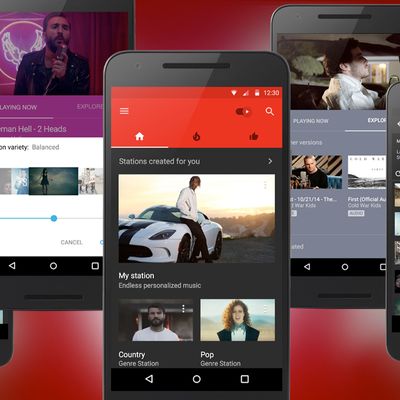
On Thursday, YouTube launched a new music app for both Android and iPhone (it will not be available on desktop) called YouTube Music, adding yet another streaming service to an already overcrowded list.
Before we get into what works and what doesn’t here, a moment of real talk: I’m over new music-streaming services. They are all pretty much the same, and instead of revolutionizing our tastes or expanding our knowledge, they’ve created a culture in which anything released before 1980 belongs in the virtual recycling bin, located underneath shelves of shiny new releases that are charting, breaking streaming records, and/or perfect for the weekend turn-up. All of which is fine, but it has made the experience of streaming low-key unbearable to those of us who would prefer to be recommended a wide breadth of musical genres and eras.
YouTube, like SoundCloud, has always been a bit of a different beast in the music-streaming game. It’s not exactly a music-streaming service, but on any given day I usually have at least one tab on my browser queued up with a YouTube video. It’s not always music — sometimes it’s a video of a sound bite, or a trailer, or a new web series I’m hate-watching. But if I’m listening to music on YouTube, it’s usually for one of two reasons: Either it’s a music video with some element of performance footage, or it’s a song I can’t find anywhere else. For instance, after Miley Cyrus’s VMA performance of “Dooo It,” in which she spouts “I ain’t no hippie,” I was reminded of a random, dirty 1968 soul burner called “You Ain’t No Hippie,” and the only place I could find it was on YouTube. (This right here is my shit.)
In addition to filling in those tiny cracks in the cloud catalogue, YouTube has the added benefit of live vintage and contemporary performance footage. For years, the Kinks’ catalogue was not available on any streaming services. One of the ways I contented myself was by watching this classic video of the band playing “Last of the Steam-Powered Trains” and “Picture Book” live on YouTube.
A friend introduced me to Sparks’ Kimono My House years ago, but it wasn’t until I watched this video of the band performing “Amateur Hour” live on television in the 1970s that I got the band’s sardonic humor (ditto Slade’s “Gudbuy T’Jane.”)
Rather smartly, instead of taking this trove of content and trying to launch yet another traditional music-streaming service, YouTube Music simply offers an easier way to listen to music on YouTube. Pulling any of these videos up in the app surfaces a playlist of related videos, much like the way YouTube functions on your browser already. (Don’t worry, YouTube actively suppresses horrible karaoke covers, so you don’t have to worry about corny videos like this popping up in your playlist. But listening to “Stay” by Rihanna will pull up more RiRi and, based on my taste, Low’s great cover.)
YouTube Music is free, but can be used as part of YouTube’s newly launched YouTube Red membership program if you don’t want to deal with ads. It costs $9.99, it works across mobile devices, desktop, connected TVs, and on the YouTube Gaming app. A free 30-day trial is available in the U.S. It also comes with access to Google Play Music. Like Google Play Music, YouTube Music includes some of the same features offered by traditional music-streaming services; you can “favorite” songs, you can save playlists, and you can listen to music offline. (One caveat on that last one: The only music you can listen to offline is a playlist created by YouTube Music curated based on your “likes” that’s updated with new songs every day. T. Jay Fowler, Head of Music Products at YouTube, claimed to me that their research shows most users don’t actually use the offline mode.) If you’re looking to hear music with no visuals and to save data, the app has an audio-only function as well.
YouTube Music does not have World Record premieres. There’s no exclusive Prince release. There are no charts that tell you where a song is trending. But, to borrow a word from the tech-jargon playbook, everything has been optimized to create a more pleasurable music-listening experience for the videos you’re already watching or listening to on YouTube. That’s it. It’s not game-changing, it’s not “disrupting” the world of music streaming, and quite frankly, that’s what I like about it.
When Spotify launched back in 2011, I was overwhelmed by the possibility of having the world’s entire music catalogue at my fingertips. I thought back to all the bands I heard about in high school but never listened to because I couldn’t afford to buy the albums. I thought about all of the band names I scribbled on the back of scrap paper in college so I could remember to rip them from Limewire when I got back to my dorm room. I thought about all of the Lou Reed records I hadn’t heard yet. It felt revolutionary, and for a time it was — until of course, it wasn’t.
This year music streaming kind of sucked the life out of music, and the last thing we need is another app that tries to show us how technology can make you fall in love with music again. If anything, music streaming is a reminder that the tech industry’s disrupt-or-perish model does not constantly need to be applied to the selling of art, as much as a music industry still grappling for magic business models might hope. YouTube Music won’t make you fall in love with music again, but it will make it easier for you to remember why you fell in love with music in the first place.

